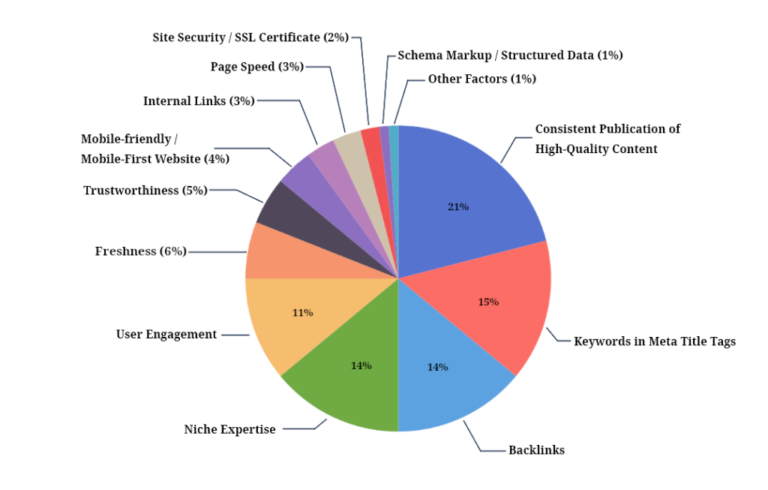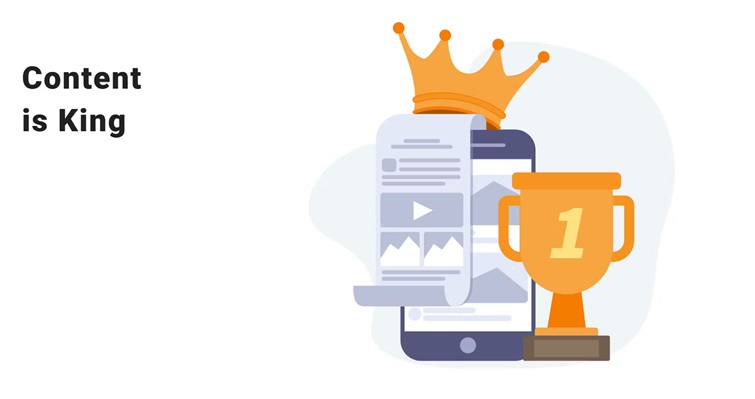7 Helpful FREE Tips To Generate Higher Rankings At Google In 2024
Looking to generate higher rankings for your website at Google this year? Below are 7 completely FREE techniques to achieve better online rankings. If you don’t have the time to optimise your site you may want to look at our search engine optimisation packages.
Table of contents
Google Algorithm Ranking Factors For 2024
1. Create High Quality Content
Write high quality content targeted to your users not to search engines. This means don’t write or copy content to try and get top rankings. In fact doing this can have the reverse affect.
Write great content targeted to answering you users questions. Take a look at the websites that appear in the top search results for the keywords you wish to target. Read these articles and then write content that provides a better explanation and user experience.
If you can provide links in your articles to other rescources to back these figures or facts up ensure you do so as this builds trust and expertise.
“Remember Google is trying to provide its users with the best possible user experience, so give them exactly that”
2. On-Page SEO
On-page SEO is the practice of optimising individual web pages to improve their search engine rankings and drive organic traffic. This involves enhancing various elements such as content quality, keyword usage, title tags, meta descriptions, header tags, URL structure, internal linking, image optimisation, user experience, and schema markup.
By focusing on these components, on-page SEO helps search engines understand the content of a page better while providing a positive experience for users.
Google is trying to return websites it feels best provides the user with what they are searching for.
Google wants to provides its users with quality information and when you provide this you will find that you will be rewarded.
Meta titles
Each page should have its own unique meta title <title>this is what it would look like in code</title>. It Should be written for users not search engines.
Not sure how to write a meta title or would like to know more on how you can write the perfect title in 2024? Read our article on how to write meta titles.
See what Google has to say about writing title tags.
- Google typically only displays the first 50 – 60 characters of your title tag.
- Front load your keywords in the title tag that you wish to generate results on. Front loading is when you place the main keyword at the beginning of the sentence. See below a screenshot when searching Google for ‘flower delivery Sydney‘.
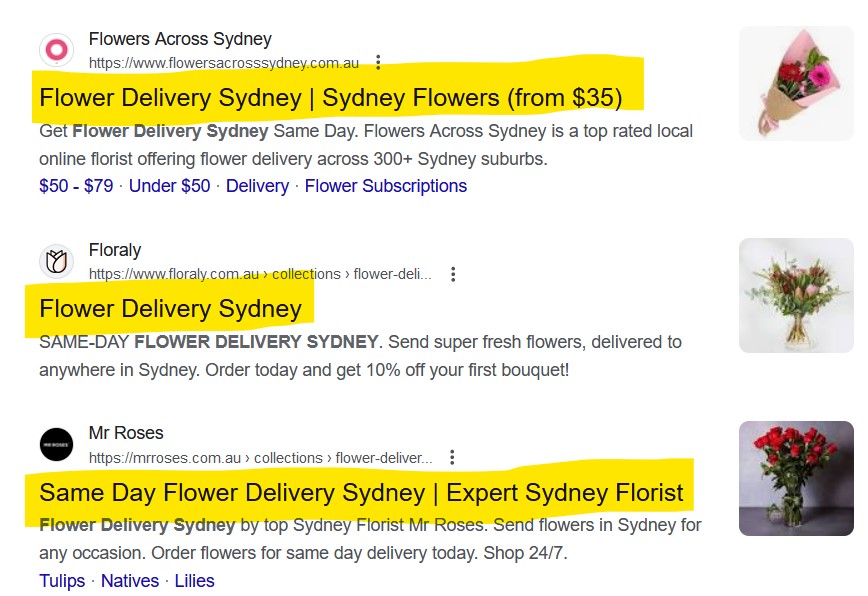
Meta descriptions
A meta description should summarise what the page is about. Each page on your site should have its own unique meta description. Not sure how to write a meta description? View our article on creating meta descriptions for your website.
Here is what Google suggests when creating meta descriptions.
- A meta description should be roughly no longer than 25 – 32 words in length. The meta description should summarise what the page is about. Ensure the key word you wish to target for the page is mentioned in the description.
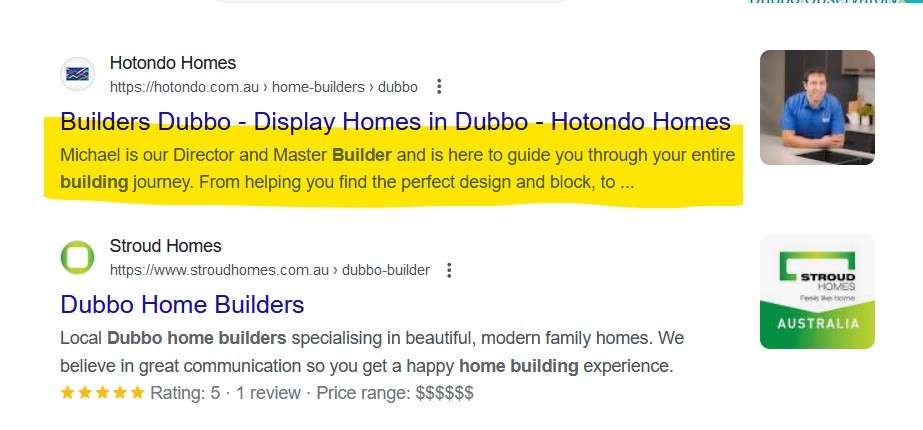
Page url ‘s
A page url is the address shown in the url bar for the websites page you are visiting.
- Ensure your url contains the main keyword you are targeting for that specific page. Keep your page urls simple and to the point.
For example if your page was try to target ‘search engine optimisation‘ the url might look something like this:

Header tags (H1-H6)
These change the font size and provide Google and other search engines with an idea on how the content is structured.
First paragraph
The first paragraph on each page should contain the keyword you wish to target or at least a variation of it. Lets say you wanted to target the words ‘home builder in Dubbo’ see how the first organic Google result at Google Hotondo Homes the first paragraph contains this information:
Breadcrumbs
A great way to provide clear navigation to your users is by integrating breadcrumbs onto your website.
Remember Google is looking for ‘user experience’. Make it as easy as possible for people to navigate your website.
Optimise your images
See what Google has to say about optimising your images. We recommend you do the following:
- Alt tags: An alt tags helps screen reading tools describe an image to visually impaired persons. It also provides search engines such as Google with useful information on what the image is.
- File size: Ensure your images take up less server space and this also helps with your page load times. A free tool to optimise your images which we have used on this site is TinyPNG.
- Image name: Give each image and appropriate name. When you take a photo on your phone or camera it will automatically save to something like ‘ctd_usdds.jpg’ Google has no idea what this is so name rename the image. For example if the image is of a black cat then save the image as ‘black cat’.

Internal linking
Linking to other relevant pages within your website helps your customers navigate to other relevant resources within your website. Content clusters are a fantastic way to achieve this.
You can see plenty of examples in this article on internal linking were we have linked to other articles on this website.
3. Quality Back Links (part of off page SEO)
Off page SEO is crucial in 2024 to build your online presence and trust with Google and other search engines. Learn how to create high quality back links to your website.
Have other websites link back to your website. Remember the higher Domain Authority a site has the better. MOZ explains Domain Authority here.
Gone are the days of getting as many back links as possible to point back to your website. As matter of fact adding your site to irrelevant websites to gain back links will have a negative affect on your website rankings.
- Quality over quantity Add your website to quality sites. Take your time to find websites that provide relevant categories and add value to your business. Then request a link from their site pointing back to yours.
- NAP Google likes to see consistent information especially when it comes to your business Name, Address and Phone Number (NAP).
- Social Media Use social media such as Facebook, Twitter, YouTube, Instagram and Linkedin to promote your business and link back to your website.
- GMB is also another great back way to link back to your site and generate local search results.
4. User Engagement
User engagement is a metric used to show the interaction of customers on your websites and the actions they take. For example this might be a user downloading your content, sharing it or purchasing a product directly from the site.
Tracking user engagement on your website is crucial as it allows you to see what is working for you and the weak points that should be addresses to provide your users and your business with a better outcome.
5. Trustworthiness
Be a trustworthy source of information. Provide statistics and links to other trusted sources to back up information you have posted on your website.
Trustworthiness isn’t a direct ranking factor however:
‘Trustworthiness helps to build credibility and establish a strong online presence, which can lead to better search rankings and increased traffic.’ Source Market Brew Ai.
6. Website Speed
Make sure your website loads quickly. You can check your website load time using Google Page Speed Insights or GTmetrix.
There are several ways to increase your website speed including using a CDN like Cloudflare and optimising your sites files and coding. If you use WordPress a great easy to use plugin to help increase website load times is WP Rocket.
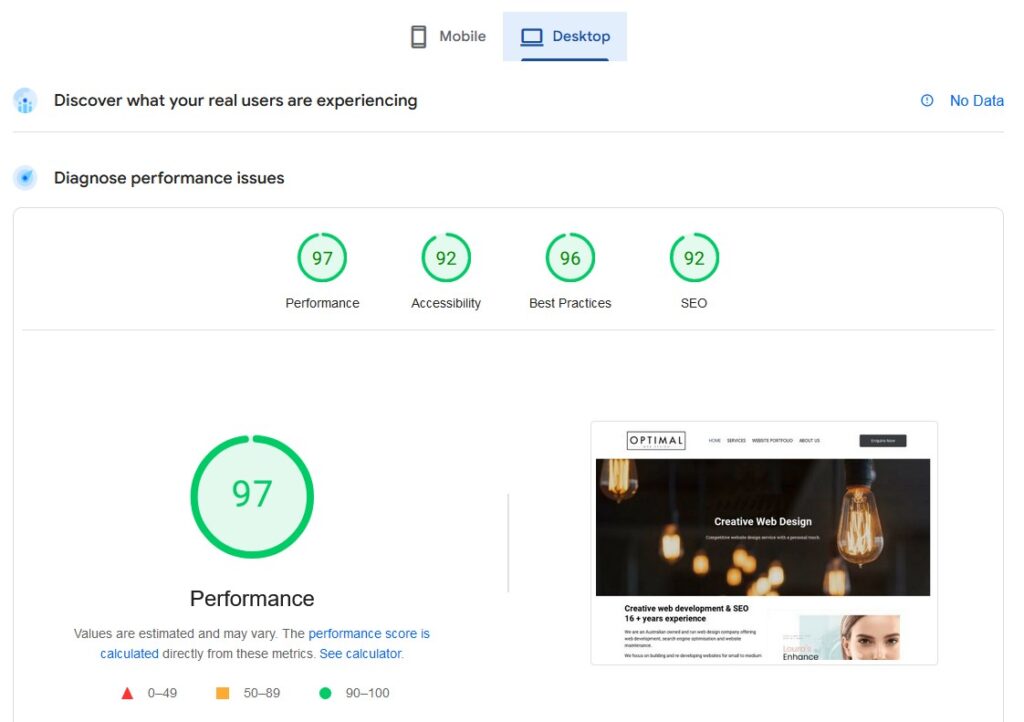
7. Mobile Responsive
Ensuring your website is responsive on a mobile is one of the key elements to generating higher rankings in 2024. It is crucial your website loads in an easy to use format on smaller screens such as mobile devices and tablets.
Make sure your website is mobile friendly and meets Googles Mobile site and mobile-first indexing best practices.

